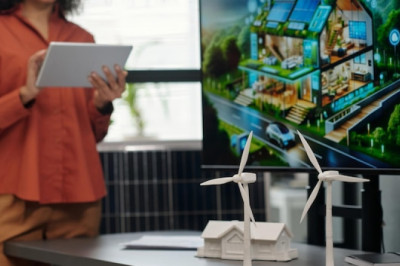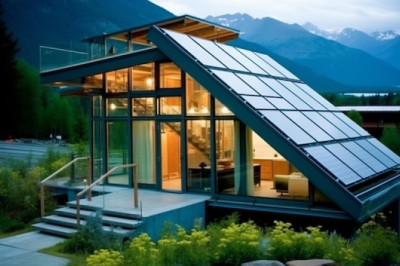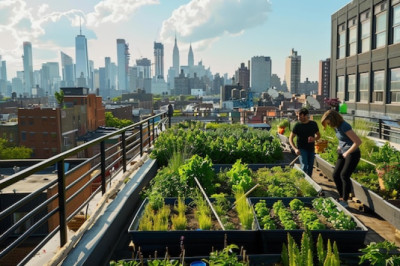As cities continue to grow, the need for sustainable and innovative solutions to combat global warming and extreme weather has never been more critical. One such solution gaining popularity worldwide is the development of rooftop green spaces. These eco-friendly havens not only provide a respite from urban heat islands but also offer numerous environmental benefits, including reducing building energy consumption, managing stormwater runoff, and enhancing biodiversity. In this article, we explore six groundbreaking designs of rooftop green spaces that are setting new standards in urban sustainability and resilience.
The Urban Oasis: High-Tech Hydroponic Rooftops
The Urban Oasis concept revolutionizes traditional green roofing by integrating advanced hydroponic systems. These systems allow for the cultivation of plants without soil, using mineral nutrient solutions in an aqueous solvent instead. This method is particularly beneficial in urban areas where soil quality and space may be limited. By utilizing vertical farming techniques, these rooftops can produce food at a higher yield and with less water than conventional farming methods. Moreover, the inclusion of smart technology enables precise control over environmental conditions, optimizing plant growth and reducing resource waste. The Urban Oasis design not only contributes to local food security but also acts as a natural insulator, lowering the need for heating and cooling in buildings.
The Pollinator Paradise: Biodiversity Boosting Rooftops
Recognizing the critical role pollinators play in our ecosystems, the Pollinator Paradise design focuses on creating rooftop spaces that support bees, butterflies, and other pollinating insects. These green roofs are planted with a variety of native flowers and shrubs to provide nectar and pollen throughout the growing season. Beyond aiding pollination, these spaces serve as crucial habitats for urban wildlife, contributing to increased biodiversity within city landscapes. Additionally, they help to mitigate the heat island effect, improve air quality, and manage stormwater runoff, making them a multifaceted solution to urban environmental challenges.
The Eco-Retreat: Recreational Green Roofs
The Eco-Retreat design transforms rooftops into recreational spaces that offer city dwellers a much-needed escape from the concrete jungle. These green roofs are designed with walkways, seating areas, and even small ponds or fountains, creating a serene environment for relaxation and social interaction. The vegetation used in these spaces not only enhances the aesthetic appeal but also provides significant environmental benefits, such as reducing ambient temperatures, improving air quality, and supporting local wildlife. By offering a blend of leisure and ecological functionality, Eco-Retreat rooftops present a compelling model for future urban green spaces.
The Stormwater Sponge: Innovative Water Management Roofs
In response to the increasing frequency of extreme weather events, the Stormwater Sponge design emphasizes the role of green roofs in managing stormwater runoff. These rooftops are engineered with layers of absorbent materials that capture and slowly release rainwater, significantly reducing the burden on urban drainage systems. This not only helps to prevent flooding but also purifies the water by filtering out pollutants through the plants' root systems. Furthermore, by retaining rainwater, these roofs can maintain cooler surface temperatures and provide sustained hydration to the vegetation, enhancing their resilience to heat and drought conditions.
The Solar Synergy: Green Roofs Integrated with Photovoltaics
The Solar Synergy design marries the concept of green roofing with renewable energy generation by integrating photovoltaic (PV) panels into the landscape. This innovative approach allows buildings to harness solar energy while maintaining the environmental benefits of a green roof. The vegetation beneath the PV panels provides a cooling effect, which can increase the efficiency of the solar panels by lowering their operating temperature. Additionally, this setup creates a habitat for wildlife and offers aesthetic and recreational value to the building occupants. The dual benefit of energy production and environmental enhancement makes Solar Synergy rooftops a promising direction for sustainable urban development.
The Climate Buffer: Heat-Resilient Green Roofs
The Climate Buffer design focuses on creating green roofs that are specifically engineered to withstand extreme heat and sunlight, making them ideal for regions prone to high temperatures and drought. These rooftops use a selection of drought-resistant plants and reflective materials to minimize heat absorption, effectively cooling the building below and the surrounding air. Advanced irrigation systems ensure that the vegetation receives adequate water with minimal waste, while the soil and plants provide additional insulation to the building. By mitigating the urban heat island effect and reducing energy consumption for air conditioning, Climate Buffer rooftops offer a practical solution for adapting urban environments to the challenges of global warming.











Comments
0 comment